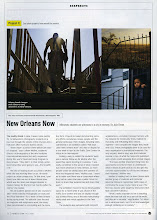
Well, I’m back in Minnesota, and you are all still down there, making better and better pictures. I took some time today to think about what I’ve seen, heard, and learned from you over the last few days—here’s what I came up with:
I have seen waterlines.
I have seen sleep deprived students make wonderful photographs, then voluntarily get up at 5:30am to do it all over again.
I have seen a lot of FEMA X’s.
I have seen the fear of the new or different melt away in students into courageous acts of friendliness to strangers, and receipt the friendliness back in kind.

I have seen a student decide that certain pictures should not be made.
I have seen, defiant of contemporary convention, a student shoot only film.
I have seen a ghost’s hand in the vacant ruin of a prep school and believed.
I have seen the sunrise with my back to it because, in truth, for a photographer, it’s better that way.
I now know what DAM means, but pretty much everyone knows that I am hard pressed to remember all three words on the fly.
I have, on more than one occasion seen the number “1” in the bottom part of the X.
I have seen a student who dislikes seafood eat a raw oyster, and

deny the urge to spit it out.
I am now convinced that it is unlikely that many of my students and one of my faculty will ever make it past the first day on “Survivor”.
I have seen students realize that certain pictures cannot be made.
I have heard the exclamation, “you would be surprised at how many times Bob Dylan refers to levees in his songs. And you know what? One song is called ‘The Levee’”, then silence for a few fleeting minutes for the first time in two days.
I now know that “Torpedo Level” isn’t code for a certain combination of equipment, but is in fact, a level that does not look like a torpedo.

I have seen Crypts and shadows.
I have seen Rich Ryan make four separate photographs lying on the ground, but none standing up.
I have seen students not photograph something they should have.
I have witnessed a student not eat a crawfish when they should have.
I was, for a very short time, in a Wal-mart.

My faculty and I now intimately understand the term, “soccer mom”.
I have seen behind the scenes.
I have seen 12 different versions of the same picture and liked them all, in some way.
I suspect Brett Kallusky travels with bricks and sandbags in his backpack.
I have listened, really listened, to the sound of the Hasselblad shutter, but I do not yet know why.
I met someone who has touched Napoleon’s underpants.
I have seen an aid worker wielding a scythe like a golf club in full swing, to cut away dry brush in the abandons of Tennessee Street.
I know that the stairs are level, because a torpedo level cannot lie the way a photograph can.

I have seen a rainbow of flannel pajama bottoms in the lobby of the hotel at midnight, stocking feet, a sea of laptops, Pocket Wizards, high heels, radio slaves, umbrellas, iPods, tripods and faculty teaching faculty—sometimes, all at once.
I have realized that the idea of ‘truth’ in photography is a tricky thing. If we can bring back pictures of waterlogged houses, flood and evaporation lines in tact, what will our audience really see? The light is dewy and orange—it must be morning. The grass and trees are very green, the Sweet Peas are so fragrant you can smell them in the lushness of the scene depicted—it must be Spring. But what year is it? In a culture of a 24-hour news cycle feeding us the disaster of the minute, what do we really know?
I have realized that for every 125 photographs I make hand-holding my camera, I only capture one mundane second.
I have seen waterlines.
 All I can say is, "wow". Last night's opening was spectacular. All of the students who participated in the Travel and Study Program had work in the show--some exhibiting their work publicly for the first time in their young careers. Jorie Tappa, after some technical difficulties, premiered three short films from the trip, and faculty exhibited their work in a separate studio space upstairs in the Traffic Zone Center for Visual Art.
All I can say is, "wow". Last night's opening was spectacular. All of the students who participated in the Travel and Study Program had work in the show--some exhibiting their work publicly for the first time in their young careers. Jorie Tappa, after some technical difficulties, premiered three short films from the trip, and faculty exhibited their work in a separate studio space upstairs in the Traffic Zone Center for Visual Art.































